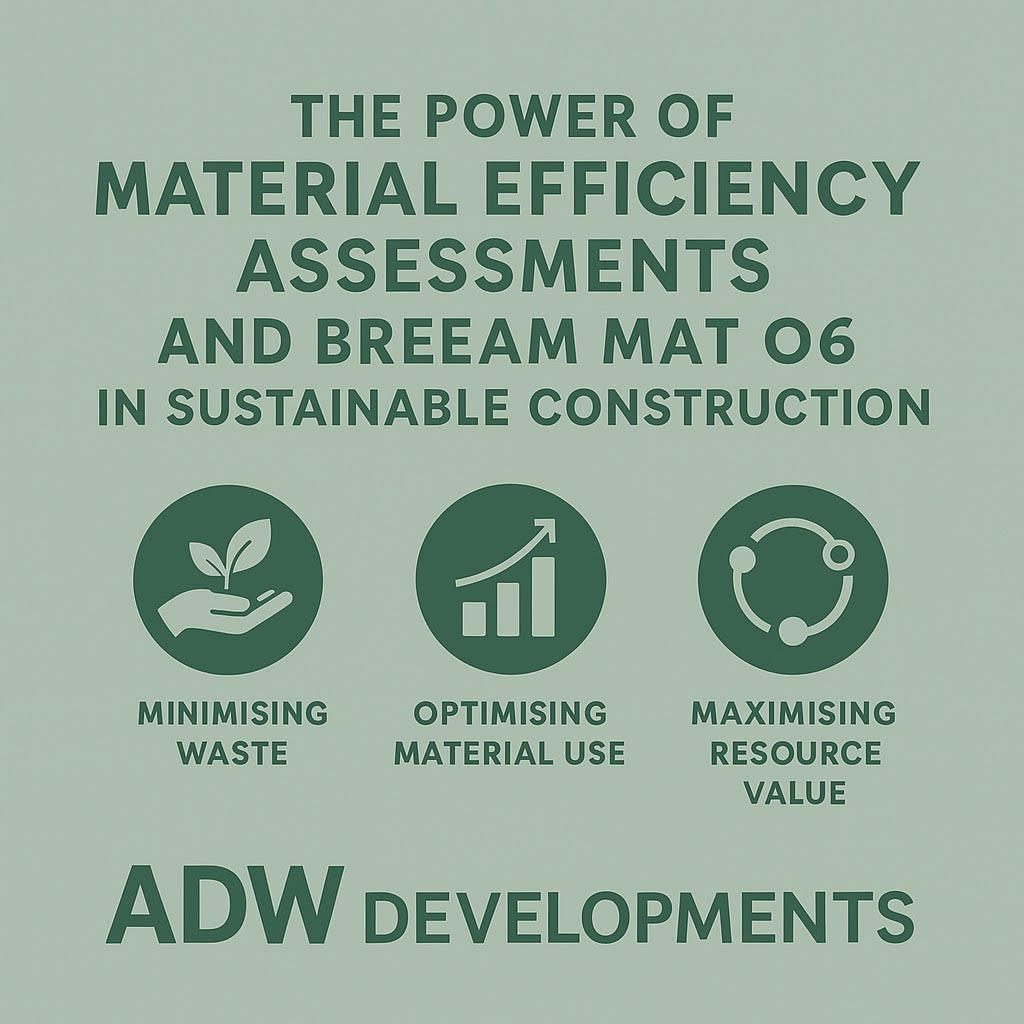BREEAM Mat 06 is a key topic in sustainable construction, and today we take a closer look. As one of the largest consumers of raw materials and producers of waste, the construction industry faces growing pressure to build more responsibly. Material Efficiency Assessments provide a structured approach to reducing environmental impact, conserving resources, and enhancing overall project sustainability.
At the heart of this effort is BREEAM Mat 06, a framework that helps projects minimise waste, maximise resource value, and integrate circular economy principles from the earliest stages of design.
In this article, we explore how BREEAM Mat 06 supports smarter material use, improves building performance, and advances a more sustainable, future-ready construction sector.

What is Material Efficiency?
Material efficiency in construction means making the best possible use of materials throughout a project’s lifecycle to minimise waste, reduce environmental impact, and conserve resources. It involves strategies that add value at every stage, from extraction and manufacturing to installation, use, and end-of-life.
Key principles include:
- Minimising waste: Reducing waste at every stage, from optimised design dimensions to careful on-site management and recycling.
- Optimising material use: Selecting materials that are durable, fit for purpose, and achieve high performance with less resource input.
- Maximising resource value: Prioritising recycled and reused materials, and designing for future disassembly and recovery.
- Reducing embodied carbon: Choosing low-carbon materials to limit the greenhouse gas emissions associated with their production and delivery.
Ultimately, material efficiency forms a cornerstone of sustainable construction, reducing environmental impacts, lowering costs, and improving long-term resource security.
BREEAM Mat 06: Driving Material Efficiency in Practice
BREEAM (Building Research Establishment Environmental Assessment Method) is a leading global sustainability assessment method for buildings and infrastructure. Within its framework, Mat 06 – Material Efficiency recognises and rewards projects that take proactive steps to optimise resource use and minimise material-related environmental impacts.
To achieve the Mat 06 credit, projects must demonstrate a robust, strategic approach to material efficiency through measures such as:
- Developing a Material Efficiency Strategy: Setting clear objectives, targets, and performance indicators across all project stages—from concept to completion.
- Designing for Material Efficiency:
- Standardisation and modularity to reduce cutting waste and simplify future disassembly.
- Optimised structural design to use less material while maintaining performance.
- Design for Disassembly (DfD) to support reuse and recycling at end-of-life.
- Implementing Effective Waste Management Plans: Prioritising prevention, reuse, and recycling, supported by measurable waste reduction targets.
- Selecting Sustainable Materials: Choosing products with high recycled content, local sourcing, and lower embodied carbon.
- Managing Materials On-Site: Adopting best practices for handling, segregation, and logistics to minimise waste and damage.
- Monitoring and Reporting: Tracking material flows and performance against targets to demonstrate continual improvement.
BREEAM Mat 06 encourages project teams to go beyond waste management. Actively designing waste out of the construction process and embedding circular economy thinking from the outset.
FAQs
What is Material Efficiency in construction?
It refers to optimising material use across a project to minimise waste, reduce environmental impact, and conserve natural resources.
What is BREEAM Mat 06?
BREEAM Mat 06 is a credit within the BREEAM sustainability framework that rewards projects implementing effective strategies to optimise material efficiency and reduce waste throughout the building lifecycle. It encourages a proactive, data-led approach to resource management rather than reactive waste reduction.
How does BREEAM Mat 06 encourage material efficiency?
The credit promotes a structured process that integrates material efficiency from the earliest design stages. It focuses on optimising design layouts, selecting low-impact and responsibly sourced materials, implementing robust waste management plans, and monitoring performance to ensure continual improvement.
What are the benefits of Material Efficiency Assessments?
They help reduce waste, cut costs, improve sustainability credentials, and conserve valuable resources.
Does material efficiency only apply to new builds?
No. The same principles apply to refurbishments and retrofits, helping to improve resource efficiency in existing buildings. Read more about it here.
Building Smarter, Using Less
In essence, Material Efficiency Assessments, supported by frameworks like BREEAM Mat 06, are reshaping how the industry approaches sustainability. Embedding efficiency from design to delivery helps projects cut waste, lower embodied carbon, and use resources more intelligently.
This approach is both environmentally responsible and economically sound — reducing costs, enhancing performance, and extending asset lifespans. As the shift towards net zero and circular construction accelerates, material efficiency will remain fundamental to delivering buildings that are smarter, leaner, and truly sustainable.
